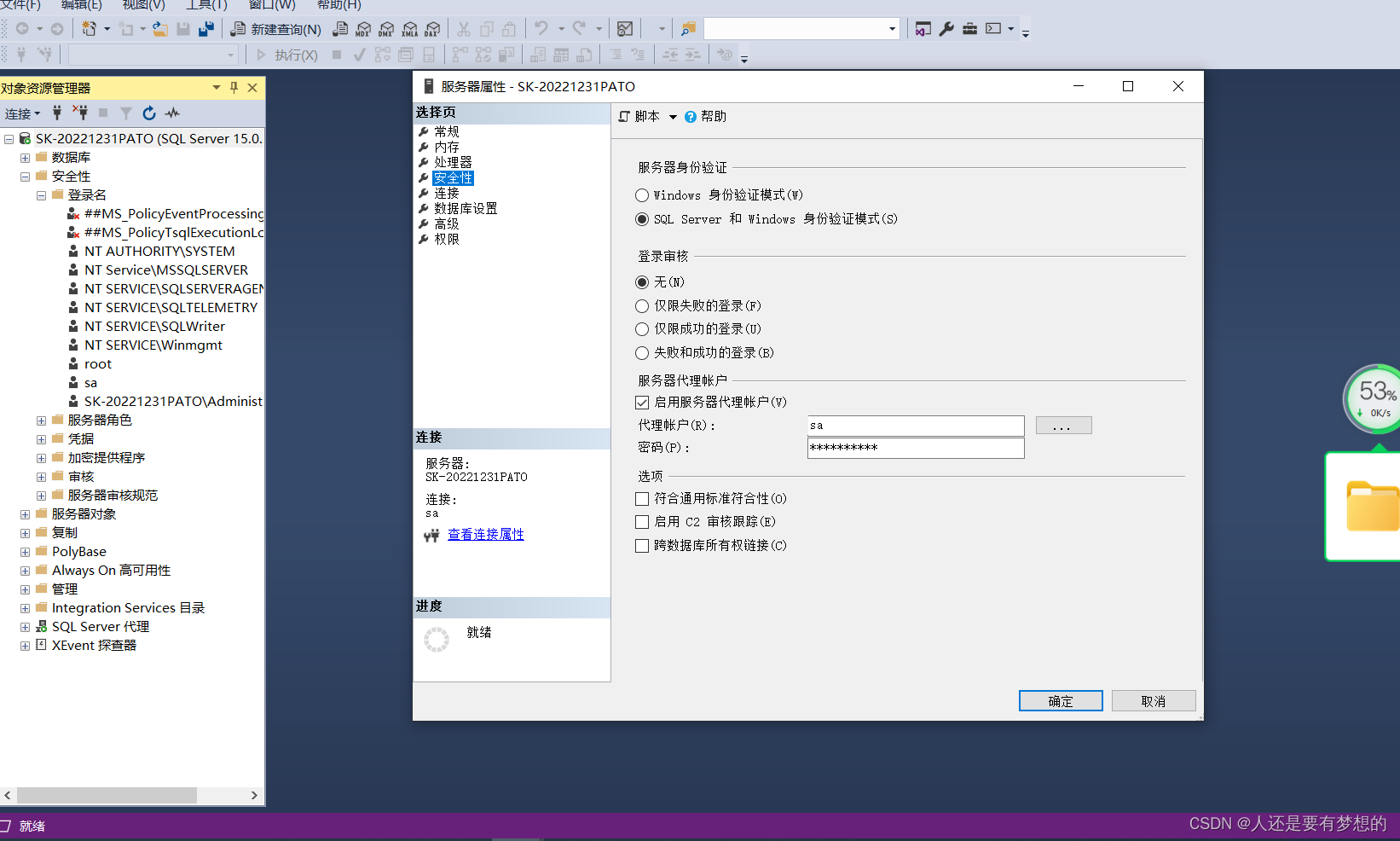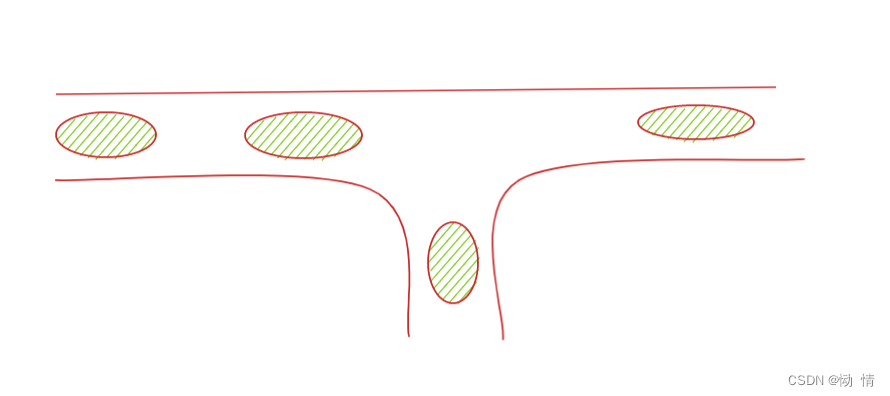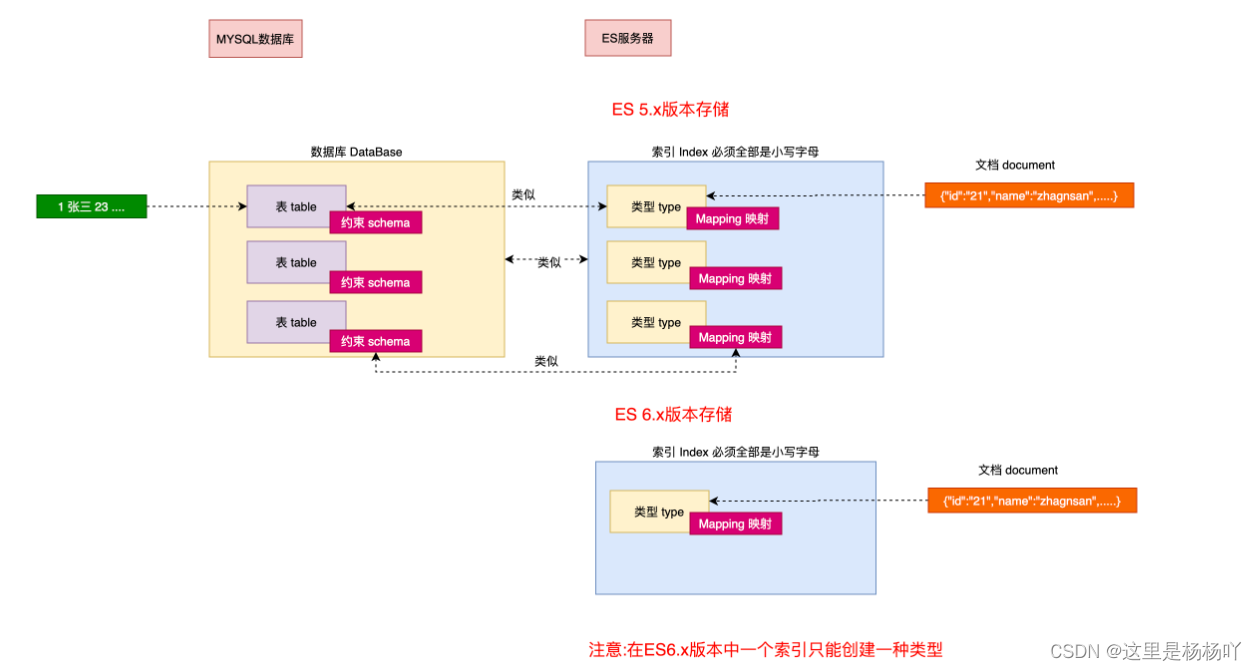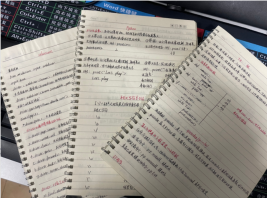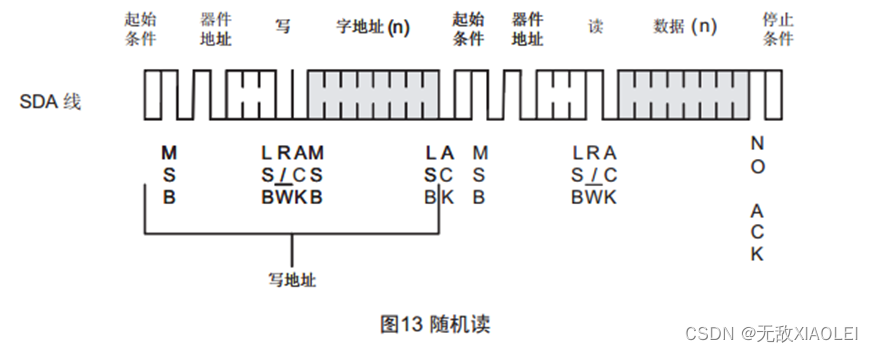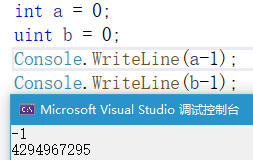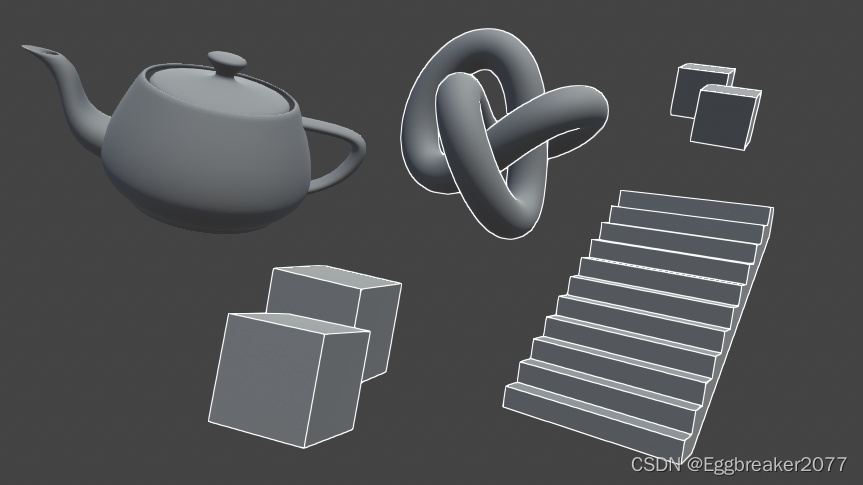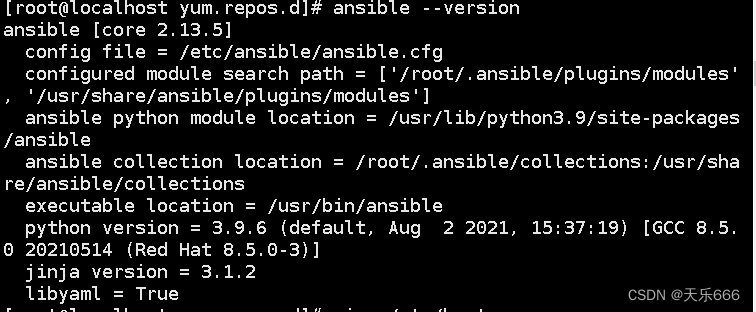本文基于Kubernetes v1.22.4版本进行源码学习,对应的client-go版本为v0.22.4
3、Informer机制
在Kubernetes系统中,组件之间通过HTTP协议进行通信,在不依赖任何中间件的情况下需要保证消息的实时性、可靠性、顺序性等。那么Kubernetes是如何做到的呢?答案就是Informer机制。Kubernetes的其他组件都是通过client-go的Informer机制与Kubernetes API Server进行通信的
1)、Informer架构
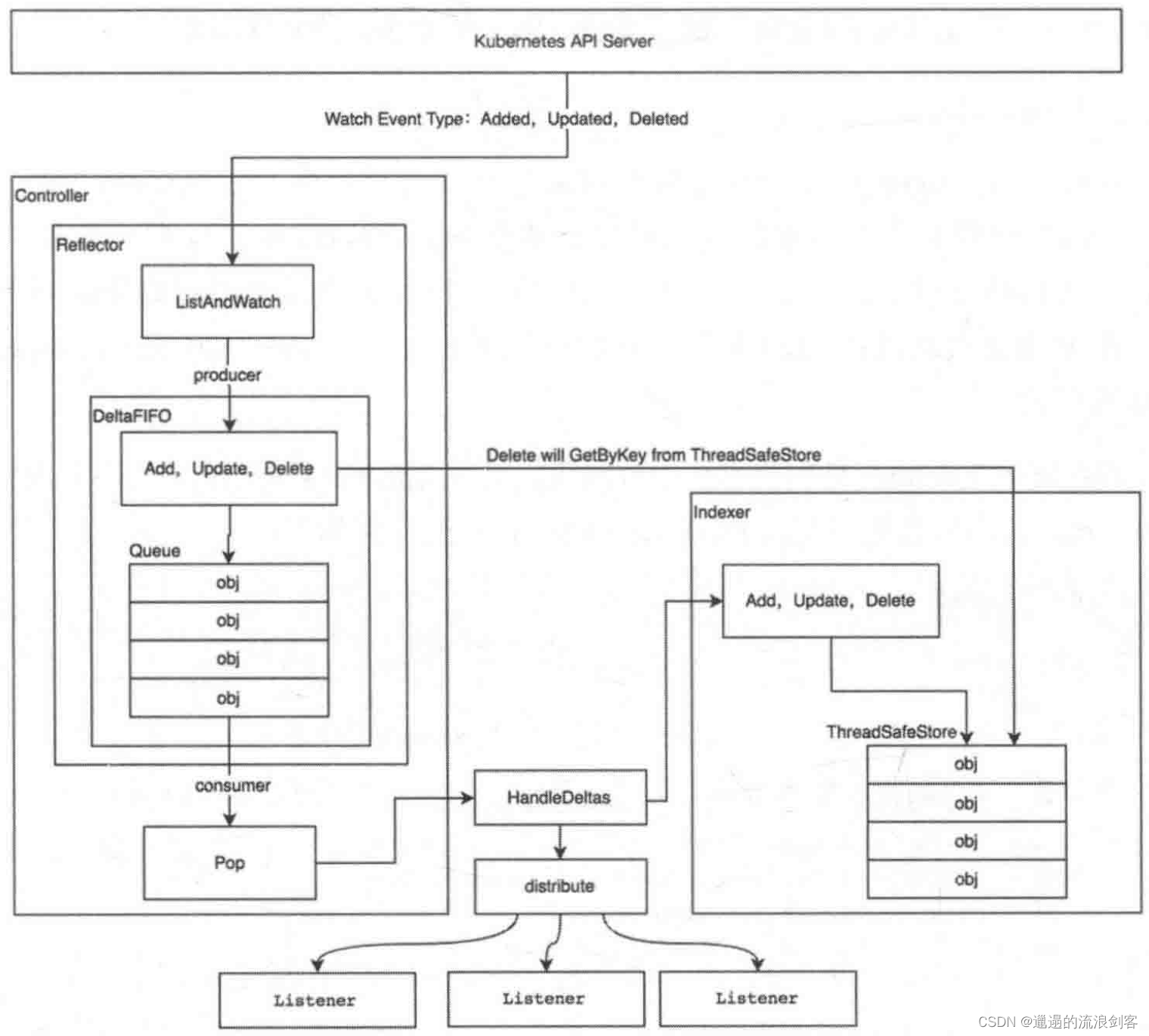
Informer架构设计中,有多个核心组件:
- Reflector:用于监听Kubernetes资源,当资源发生变化时,触发相应的变更事件,例如Added、Updated、Deleted事件,并将其资源对象存放到本地缓存DeltaFIFO中
- DeltaFIFO:可以分开理解,FIFO是一个先进先出的队列,它拥有队列操作的基本方法,例如Add、Update、Delete、List、Pop、Close等,而Delta是一个资源对象存储,它可以保存资源对象的操作类型,例如Added、Updated、Deleted、Sync等
- Indexer:client-go中用来存储资源对象并自带索引功能的本地存储,Informer从DeltaFIFO中将消费出来的资源对象存储至Indexer。Indexer中的数据与etcd集群中的数据保持完全一致。client-go可以很方便地从本地存储中读取相应的资源对象数据,而无须每次都从远程etcd集群中读取,这样可以减轻Kubernetes API Server和etcd集群的压力
2)、Reflector
Reflector从Kubernetes API Server中listAndWatch资源对象,然后将对象的变化包装成Delta并放入到DeltaFIFO中
Reflector首先通过List操作获取全量的资源对象数据,调用DeltaFIFO的Replace方法全量插入DeltaFIFO,然后后续通过Watch操作根据资源对象的变化类型相应的调用DeltaFIFO的Add、Update、Delete方法,将对象及其变化插入到DeltaFIFO中
1)Reflector初始化
代码路径:vendor/k8s.io/client-go/tools/cache/reflector.go
func NewReflector(lw ListerWatcher, expectedType interface{}, store Store, resyncPeriod time.Duration) *Reflector {
return NewNamedReflector(naming.GetNameFromCallsite(internalPackages...), lw, expectedType, store, resyncPeriod)
}
func NewNamedReflector(name string, lw ListerWatcher, expectedType interface{}, store Store, resyncPeriod time.Duration) *Reflector {
realClock := &clock.RealClock{}
r := &Reflector{
name: name,
listerWatcher: lw,
store: store,
// We used to make the call every 1sec (1 QPS), the goal here is to achieve ~98% traffic reduction when
// API server is not healthy. With these parameters, backoff will stop at [30,60) sec interval which is
// 0.22 QPS. If we don't backoff for 2min, assume API server is healthy and we reset the backoff.
backoffManager: wait.NewExponentialBackoffManager(800*time.Millisecond, 30*time.Second, 2*time.Minute, 2.0, 1.0, realClock),
initConnBackoffManager: wait.NewExponentialBackoffManager(800*time.Millisecond, 30*time.Second, 2*time.Minute, 2.0, 1.0, realClock),
resyncPeriod: resyncPeriod,
clock: realClock,
watchErrorHandler: WatchErrorHandler(DefaultWatchErrorHandler),
}
r.setExpectedType(expectedType)
return r
}
通过NewReflector实例化Reflector对象时必须传入ListerWatcher interface的实现,它拥有List和Watch方法,用于获取及监控资源列表
2)ListWatch
代码路径:vendor/k8s.io/client-go/tools/cache/listwatch.go
type ListFunc func(options metav1.ListOptions) (runtime.Object, error)
type WatchFunc func(options metav1.ListOptions) (watch.Interface, error)
type ListWatch struct {
ListFunc ListFunc
WatchFunc WatchFunc
// DisableChunking requests no chunking for this list watcher.
DisableChunking bool
}
ListWatch struct实现了ListerWatcher interface
再来看下ListWatch struct初始化的例子:
代码路径:vendor/k8s.io/client-go/informers/core/v1/pod.go
func NewPodInformer(client kubernetes.Interface, namespace string, resyncPeriod time.Duration, indexers cache.Indexers) cache.SharedIndexInformer {
return NewFilteredPodInformer(client, namespace, resyncPeriod, indexers, nil)
}
func NewFilteredPodInformer(client kubernetes.Interface, namespace string, resyncPeriod time.Duration, indexers cache.Indexers, tweakListOptions internalinterfaces.TweakListOptionsFunc) cache.SharedIndexInformer {
return cache.NewSharedIndexInformer(
&cache.ListWatch{
ListFunc: func(options metav1.ListOptions) (runtime.Object, error) {
if tweakListOptions != nil {
tweakListOptions(&options)
}
return client.CoreV1().Pods(namespace).List(context.TODO(), options)
},
WatchFunc: func(options metav1.ListOptions) (watch.Interface, error) {
if tweakListOptions != nil {
tweakListOptions(&options)
}
return client.CoreV1().Pods(namespace).Watch(context.TODO(), options)
},
},
&corev1.Pod{},
resyncPeriod,
indexers,
)
}
在NewPodInformer初始化Pod对象的informer中,会初始化ListWatch struct并定义ListFunc和WatchFunc,可以看到ListFunc和WatchFunc即为其资源对象客户端的List与Watch方法
3)ListAndWatch函数
在Reflector源码实现中,其中最重要的是ListAndWatch函数,它负责获取资源列表和监听指定的Kubernetes API Server资源,ListAndWatch函数实现可分为三部分:List操作、Resync操作、Watch操作
a)List操作
List在程序第一次运行时获取该资源下所有的对象数据并将其存储至DeltaFIFO中,相关源码如下:
代码路径:vendor/k8s.io/client-go/tools/cache/reflector.go
func (r *Reflector) ListAndWatch(stopCh <-chan struct{}) error {
// 1.List操作(只执行一次)
klog.V(3).Infof("Listing and watching %v from %s", r.expectedTypeName, r.name)
var resourceVersion string
// 1)设置ListOptions,将resourceVersion设置为"0"
options := metav1.ListOptions{ResourceVersion: r.relistResourceVersion()}
if err := func() error {
initTrace := trace.New("Reflector ListAndWatch", trace.Field{"name", r.name})
defer initTrace.LogIfLong(10 * time.Second)
var list runtime.Object
var paginatedResult bool
var err error
listCh := make(chan struct{}, 1)
panicCh := make(chan interface{}, 1)
// 2)调用r.listerWatcher.List方法,执行list操作,获取全量的资源对象
go func() {
defer func() {
if r := recover(); r != nil {
panicCh <- r
}
}()
// Attempt to gather list in chunks, if supported by listerWatcher, if not, the first
// list request will return the full response.
pager := pager.New(pager.SimplePageFunc(func(opts metav1.ListOptions) (runtime.Object, error) {
return r.listerWatcher.List(opts)
}))
switch {
case r.WatchListPageSize != 0:
pager.PageSize = r.WatchListPageSize
case r.paginatedResult:
// We got a paginated result initially. Assume this resource and server honor
// paging requests (i.e. watch cache is probably disabled) and leave the default
// pager size set.
case options.ResourceVersion != "" && options.ResourceVersion != "0":
// User didn't explicitly request pagination.
//
// With ResourceVersion != "", we have a possibility to list from watch cache,
// but we do that (for ResourceVersion != "0") only if Limit is unset.
// To avoid thundering herd on etcd (e.g. on master upgrades), we explicitly
// switch off pagination to force listing from watch cache (if enabled).
// With the existing semantic of RV (result is at least as fresh as provided RV),
// this is correct and doesn't lead to going back in time.
//
// We also don't turn off pagination for ResourceVersion="0", since watch cache
// is ignoring Limit in that case anyway, and if watch cache is not enabled
// we don't introduce regression.
pager.PageSize = 0
}
list, paginatedResult, err = pager.List(context.Background(), options)
if isExpiredError(err) || isTooLargeResourceVersionError(err) {
r.setIsLastSyncResourceVersionUnavailable(true)
// Retry immediately if the resource version used to list is unavailable.
// The pager already falls back to full list if paginated list calls fail due to an "Expired" error on
// continuation pages, but the pager might not be enabled, the full list might fail because the
// resource version it is listing at is expired or the cache may not yet be synced to the provided
// resource version. So we need to fallback to resourceVersion="" in all to recover and ensure
// the reflector makes forward progress.
list, paginatedResult, err = pager.List(context.Background(), metav1.ListOptions{ResourceVersion: r.relistResourceVersion()})
}
close(listCh)
}()
select {
case <-stopCh:
return nil
case r := <-panicCh:
panic(r)
case <-listCh:
}
if err != nil {
return fmt.Errorf("failed to list %v: %v", r.expectedTypeName, err)
}
// We check if the list was paginated and if so set the paginatedResult based on that.
// However, we want to do that only for the initial list (which is the only case
// when we set ResourceVersion="0"). The reasoning behind it is that later, in some
// situations we may force listing directly from etcd (by setting ResourceVersion="")
// which will return paginated result, even if watch cache is enabled. However, in
// that case, we still want to prefer sending requests to watch cache if possible.
//
// Paginated result returned for request with ResourceVersion="0" mean that watch
// cache is disabled and there are a lot of objects of a given type. In such case,
// there is no need to prefer listing from watch cache.
if options.ResourceVersion == "0" && paginatedResult {
r.paginatedResult = true
}
r.setIsLastSyncResourceVersionUnavailable(false) // list was successful
initTrace.Step("Objects listed")
listMetaInterface, err := meta.ListAccessor(list)
if err != nil {
return fmt.Errorf("unable to understand list result %#v: %v", list, err)
}
// 3)根据list返回的结果,获取最新的resourceVersion
resourceVersion = listMetaInterface.GetResourceVersion()
initTrace.Step("Resource version extracted")
// 4)将list返回的结果转换为[]runtime.Object
items, err := meta.ExtractList(list)
if err != nil {
return fmt.Errorf("unable to understand list result %#v (%v)", list, err)
}
initTrace.Step("Objects extracted")
// 5)调用r.syncWith,将资源对象列表和resourceVersion存储(Replace)至DeltaFIFO中
if err := r.syncWith(items, resourceVersion); err != nil {
return fmt.Errorf("unable to sync list result: %v", err)
}
initTrace.Step("SyncWith done")
// 6)调用r.setLastSyncResourceVersion,更新Reflector中已被处理的最新资源对象的resourceVersion值
r.setLastSyncResourceVersion(resourceVersion)
initTrace.Step("Resource version updated")
return nil
}(); err != nil {
return err
}
...
List操作(只执行一次)逻辑如下:
- 设置ListOptions,将resourceVersion设置为"0"
- 调用
r.listerWatcher.List方法,执行list操作,获取全量的资源对象 - 根据list返回的结果,获取最新的resourceVersion
- 将list返回的结果转换为[]runtime.Object
- 调用
r.syncWith,将资源对象列表和resourceVersion存储(Replace)至DeltaFIFO中 - 调用
r.setLastSyncResourceVersion,更新Reflector中已被处理的最新资源对象的resourceVersion值
resourceVersion的作用:
- 保证客户端数据一致性和顺序性
- 乐观锁,实现并发控制
设置ListOptions时,resourceVersion有三种设置方法:
- 不设置,此时会直接从etcd中读取,此时数据是最新的
- 设置为"0",此时会从API Server Cache中获取数据
- 设置为指定的resourceVersion,获取resourceVersion大于指定版本的所有资源对象
b)Resync操作
func (r *Reflector) ListAndWatch(stopCh <-chan struct{}) error {
...
// 2.Resync操作(异步循环执行)
resyncerrc := make(chan error, 1)
cancelCh := make(chan struct{})
defer close(cancelCh)
go func() {
resyncCh, cleanup := r.resyncChan()
defer func() {
cleanup() // Call the last one written into cleanup
}()
for {
select {
case <-resyncCh:
case <-stopCh:
return
case <-cancelCh:
return
}
// 1)判断是否需要执行Resync操作,即重新同步
if r.ShouldResync == nil || r.ShouldResync() {
klog.V(4).Infof("%s: forcing resync", r.name)
// 2)如果需要,则调用r.store.Resync进行重新同步
if err := r.store.Resync(); err != nil {
resyncerrc <- err
return
}
}
cleanup()
resyncCh, cleanup = r.resyncChan()
}
}()
...
Resync操作(异步循环执行)逻辑如下:
- 判断是否需要执行Resync操作,即重新同步
- 如果需要,则调用
r.store.Resync进行重新同步
c)Watch操作
func (r *Reflector) ListAndWatch(stopCh <-chan struct{}) error {
...
// 3.Watch操作(循环执行)
for {
// 1)根据stopCh判断是否需要退出循环
// give the stopCh a chance to stop the loop, even in case of continue statements further down on errors
select {
case <-stopCh:
return nil
default:
}
timeoutSeconds := int64(minWatchTimeout.Seconds() * (rand.Float64() + 1.0))
// 2)设置ListOptions,将resourceVersion设置为最新的resourceVersion,即从list返回的最新的resourceVersion开始执行watch操作
options = metav1.ListOptions{
ResourceVersion: resourceVersion,
// We want to avoid situations of hanging watchers. Stop any wachers that do not
// receive any events within the timeout window.
TimeoutSeconds: &timeoutSeconds,
// To reduce load on kube-apiserver on watch restarts, you may enable watch bookmarks.
// Reflector doesn't assume bookmarks are returned at all (if the server do not support
// watch bookmarks, it will ignore this field).
AllowWatchBookmarks: true,
}
// start the clock before sending the request, since some proxies won't flush headers until after the first watch event is sent
start := r.clock.Now()
// 3)调用r.listerWatcher.Watch,开始监听操作
w, err := r.listerWatcher.Watch(options)
if err != nil {
// If this is "connection refused" error, it means that most likely apiserver is not responsive.
// It doesn't make sense to re-list all objects because most likely we will be able to restart
// watch where we ended.
// If that's the case begin exponentially backing off and resend watch request.
// Do the same for "429" errors.
if utilnet.IsConnectionRefused(err) || apierrors.IsTooManyRequests(err) {
<-r.initConnBackoffManager.Backoff().C()
continue
}
return err
}
// 4)调用r.watchHandler,处理watch操作返回来的结果
if err := r.watchHandler(start, w, &resourceVersion, resyncerrc, stopCh); err != nil {
if err != errorStopRequested {
switch {
case isExpiredError(err):
// Don't set LastSyncResourceVersionUnavailable - LIST call with ResourceVersion=RV already
// has a semantic that it returns data at least as fresh as provided RV.
// So first try to LIST with setting RV to resource version of last observed object.
klog.V(4).Infof("%s: watch of %v closed with: %v", r.name, r.expectedTypeName, err)
case apierrors.IsTooManyRequests(err):
klog.V(2).Infof("%s: watch of %v returned 429 - backing off", r.name, r.expectedTypeName)
<-r.initConnBackoffManager.Backoff().C()
continue
default:
klog.Warningf("%s: watch of %v ended with: %v", r.name, r.expectedTypeName, err)
}
}
return nil
}
}
}
Watch操作(循环执行)逻辑如下:
- 根据stopCh判断是否需要退出循环
- 设置ListOptions,将resourceVersion设置为最新的resourceVersion,即从list返回的最新的resourceVersion开始执行watch操作
- 调用
r.listerWatcher.Watch,开始监听操作 - 调用
r.watchHandler,处理watch操作返回来的结果
watchHandler用于处理资源的变更事件。当触发Added、Updated、Deleted事件时,将对应的资源对象更新到本地缓存DeltaFIFO并更新resourceVersion。代码如下:
func (r *Reflector) watchHandler(start time.Time, w watch.Interface, resourceVersion *string, errc chan error, stopCh <-chan struct{}) error {
eventCount := 0
// Stopping the watcher should be idempotent and if we return from this function there's no way
// we're coming back in with the same watch interface.
defer w.Stop()
loop:
for {
select {
case <-stopCh:
return errorStopRequested
case err := <-errc:
return err
// 1)从watch操作返回来的结果中获取event事件
case event, ok := <-w.ResultChan():
if !ok {
break loop
}
if event.Type == watch.Error {
return apierrors.FromObject(event.Object)
}
if r.expectedType != nil {
if e, a := r.expectedType, reflect.TypeOf(event.Object); e != a {
utilruntime.HandleError(fmt.Errorf("%s: expected type %v, but watch event object had type %v", r.name, e, a))
continue
}
}
if r.expectedGVK != nil {
if e, a := *r.expectedGVK, event.Object.GetObjectKind().GroupVersionKind(); e != a {
utilruntime.HandleError(fmt.Errorf("%s: expected gvk %v, but watch event object had gvk %v", r.name, e, a))
continue
}
}
meta, err := meta.Accessor(event.Object)
if err != nil {
utilruntime.HandleError(fmt.Errorf("%s: unable to understand watch event %#v", r.name, event))
continue
}
// 2)获得当前watch到资源的resourceVersion
newResourceVersion := meta.GetResourceVersion()
// 3)当触发Added、Updated、Deleted事件时,将对应的资源对象更新到本地缓存DeltaFIFO
switch event.Type {
case watch.Added:
err := r.store.Add(event.Object)
if err != nil {
utilruntime.HandleError(fmt.Errorf("%s: unable to add watch event object (%#v) to store: %v", r.name, event.Object, err))
}
case watch.Modified:
err := r.store.Update(event.Object)
if err != nil {
utilruntime.HandleError(fmt.Errorf("%s: unable to update watch event object (%#v) to store: %v", r.name, event.Object, err))
}
case watch.Deleted:
// TODO: Will any consumers need access to the "last known
// state", which is passed in event.Object? If so, may need
// to change this.
err := r.store.Delete(event.Object)
if err != nil {
utilruntime.HandleError(fmt.Errorf("%s: unable to delete watch event object (%#v) from store: %v", r.name, event.Object, err))
}
case watch.Bookmark:
// A `Bookmark` means watch has synced here, just update the resourceVersion
default:
utilruntime.HandleError(fmt.Errorf("%s: unable to understand watch event %#v", r.name, event))
}
*resourceVersion = newResourceVersion
// 4)调用r.setLastSyncResourceVersion,更新Reflector中已被处理的最新资源对象的resourceVersion值
r.setLastSyncResourceVersion(newResourceVersion)
if rvu, ok := r.store.(ResourceVersionUpdater); ok {
rvu.UpdateResourceVersion(newResourceVersion)
}
eventCount++
}
}
watchDuration := r.clock.Since(start)
if watchDuration < 1*time.Second && eventCount == 0 {
return fmt.Errorf("very short watch: %s: Unexpected watch close - watch lasted less than a second and no items received", r.name)
}
klog.V(4).Infof("%s: Watch close - %v total %v items received", r.name, r.expectedTypeName, eventCount)
return nil
}
3)、DeltaFIFO
DeltaFIFO可以分开理解,FIFO是一个先进先出的队列,它拥有队列操作的基本方法,例如Add、Update、Delete、List、Pop、Close等,而Delta是一个资源对象存储,它可以保存资源对象的操作类型,例如Added、Updated、Deleted、Sync等
1)DeltaFIFO结构体
代码路径:vendor/k8s.io/client-go/tools/cache/delta_fifo.go
type DeltaFIFO struct {
...
// 存放Delta,与queue中存放的key是同样的key
items map[string]Deltas
// 存储资源对象的key,可以确保顺序性
queue []string
// 默认使用MetaNamespaceKeyFunc,默认使用<namespace>/<name>的格式,不指定namespace时用<name>
keyFunc KeyFunc
...
}
type Deltas []Delta
type Delta struct {
Type DeltaType
Object interface{}
}
type DeltaType string
const (
Added DeltaType = "Added"
Updated DeltaType = "Updated"
Deleted DeltaType = "Deleted"
Replaced DeltaType = "Replaced"
Sync DeltaType = "Sync"
)
DeltaFIFO会保留所有关于资源对象的操作类型,队列中会存在拥有不同操作类型的同一资源对象,消费者在处理该资源对象时能够了解该资源对象所发生的事情
queue字段存储资源对象的key,该key通过keyFunc计算得出,默认使用MetaNamespaceKeyFunc,默认使用<namespace>/<name>的格式,不指定namespace时用<name>
items字段通过map数据结构的方式存储,value存储的是对象的Delta数组
DeltaFIFO存储结构如下图所示:
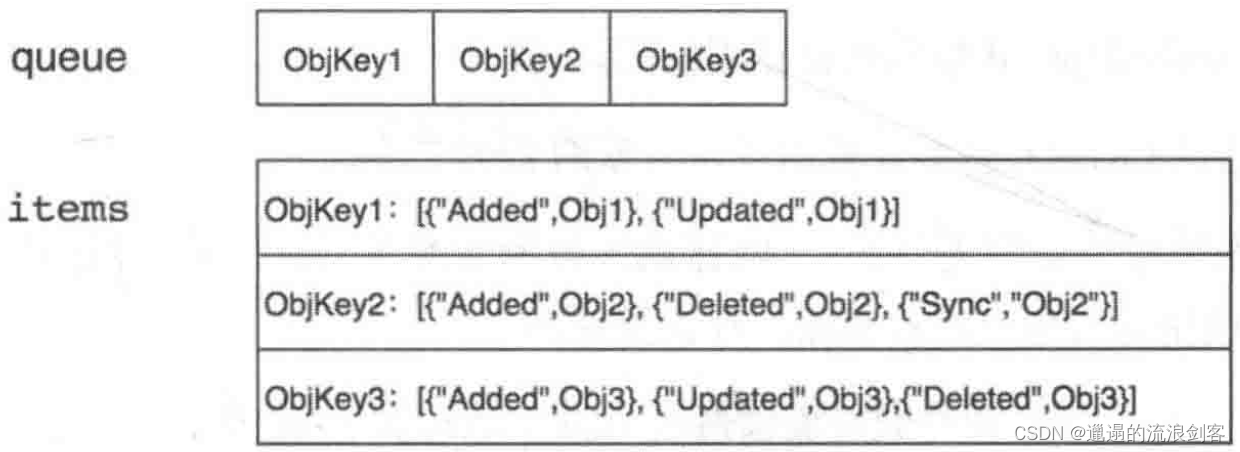
DeltaFIFO本质上是一个先进先出的队列,有数据的生产者和消费者:
生产过程:
- Reflector的List
- Reflector的Watch
- Reflector的Resync
消费过程:
- 事件派发到WorkQueue
- 刷新本地缓存
2)生产者方法
DeltaFIFO队列中的资源对象在Added、Updated、Deleted事件中都调用了queueActionLocked函数,它是DeltaFIFO实现的关键,代码如下:
func (f *DeltaFIFO) queueActionLocked(actionType DeltaType, obj interface{}) error {
// 1)计算出资源对象的key
id, err := f.KeyOf(obj)
if err != nil {
return KeyError{obj, err}
}
oldDeltas := f.items[id]
// 2)将actionType和资源对象构造成Delta,添加到items中,并通过dedupDeltas函数进行去重操作
newDeltas := append(oldDeltas, Delta{actionType, obj})
newDeltas = dedupDeltas(newDeltas)
if len(newDeltas) > 0 {
if _, exists := f.items[id]; !exists {
f.queue = append(f.queue, id)
}
f.items[id] = newDeltas
// 3)更新构造后的Delta并通过cond.Broadcast通知所有消费者解除阻塞
f.cond.Broadcast()
} else {
// This never happens, because dedupDeltas never returns an empty list
// when given a non-empty list (as it is here).
// If somehow it happens anyway, deal with it but complain.
if oldDeltas == nil {
klog.Errorf("Impossible dedupDeltas for id=%q: oldDeltas=%#+v, obj=%#+v; ignoring", id, oldDeltas, obj)
return nil
}
klog.Errorf("Impossible dedupDeltas for id=%q: oldDeltas=%#+v, obj=%#+v; breaking invariant by storing empty Deltas", id, oldDeltas, obj)
f.items[id] = newDeltas
return fmt.Errorf("Impossible dedupDeltas for id=%q: oldDeltas=%#+v, obj=%#+v; broke DeltaFIFO invariant by storing empty Deltas", id, oldDeltas, obj)
}
return nil
}
queueActionLocked逻辑如下:
- 通过
f.KeyOf函数计算出资源对象的key - 将actionType和资源对象构造成Delta,添加到items中,并通过dedupDeltas函数进行去重操作
- 更新构造后的Delta并通过
cond.Broadcast通知所有消费者解除阻塞
3)消费者方法
Pop方法作为消费者方法使用,从DeltaFIFO的头部取出最早进入队列中的资源对象数据。Pop方法需要传入process函数,用于接收并处理对象的回调方法,代码如下:
func (f *DeltaFIFO) Pop(process PopProcessFunc) (interface{}, error) {
f.lock.Lock()
defer f.lock.Unlock()
for {
for len(f.queue) == 0 {
// When the queue is empty, invocation of Pop() is blocked until new item is enqueued.
// When Close() is called, the f.closed is set and the condition is broadcasted.
// Which causes this loop to continue and return from the Pop().
if f.closed {
return nil, ErrFIFOClosed
}
// 1)当队列中没有数据时,通过f.cond.Wait阻塞等待数据,只有收到cond.Broadcast时才说明有数据被添加,解决当前阻塞状态
f.cond.Wait()
}
// 2)如果队列中不为空,取出f.queue的头部数据,将该对象传入process回调函数,由上层消费者进行处理
id := f.queue[0]
f.queue = f.queue[1:]
if f.initialPopulationCount > 0 {
f.initialPopulationCount--
}
item, ok := f.items[id]
if !ok {
// This should never happen
klog.Errorf("Inconceivable! %q was in f.queue but not f.items; ignoring.", id)
continue
}
delete(f.items, id)
err := process(item)
// 3)如果process回调函数处理错误,则将该对象重新存入队列
if e, ok := err.(ErrRequeue); ok {
f.addIfNotPresent(id, item)
err = e.Err
}
// Don't need to copyDeltas here, because we're transferring
// ownership to the caller.
return item, err
}
}
pop逻辑如下:
- 当队列中没有数据时,通过
f.cond.Wait阻塞等待数据,只有收到cond.Broadcast时才说明有数据被添加,解决当前阻塞状态 - 如果队列中不为空,取出
f.queue的头部数据,将该对象传入process回调函数,由上层消费者进行处理 - 如果process回调函数处理错误,则将该对象重新存入队列
参考:
《Kubernetes源码剖析》
2022年最新k8s编程operator篇
k8s client-go源码分析 informer源码分析(3)-Reflector源码分析
